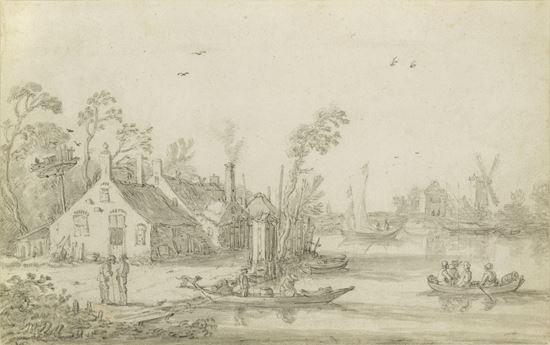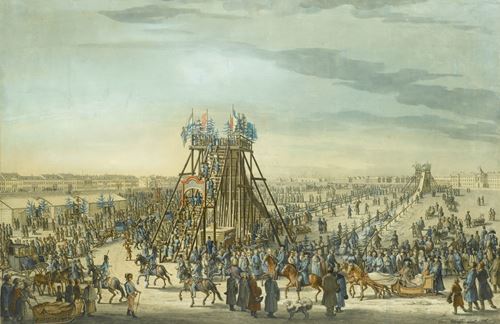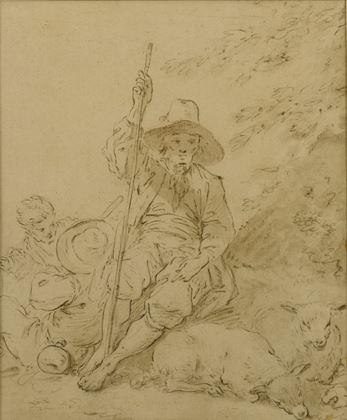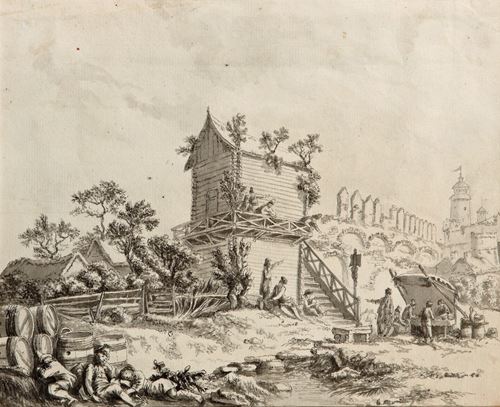saias van de Velde
(Amsterdam 1587 - The Hague 1630)
A River Scene with Rowing Boats, Cottages on the Shore and a Windmill in the Distance
bears inscription in black chalk, (lower left), either partial van Goyen monogram: ‘VG’, or partially effaced ‘VELDE’ signature
black chalk and grey wash
18.4 x 30 cm (7¼ x 11¾ in)
A quiet village and its inhabitants are depicted in A River Scene with Rowing Boats, Cottages on the Shore and a Windmill in the Distance. In the foreground, one boat carries passengers away from the river bank while in another, a figure prepares to depart, loading his possessions as a dog looks on from the shore. In the far left of the composition, two gentlemen are engaged in relaxed conversation. Behind them, a hamlet of rustic cottages stand, against which lean a wheelbarrow and other gardening tools. In the distance, a sailing boat, a bridge and a windmill are faintly illustrated.
An atmosphere of serenity pervades Esaias van de Velde’s depiction of the gently flowing river and the unhurried activities of the villagers, which is enhanced by his soft handling of the chalk. The low horizon and landscape, articulated by a diagonal river course framed by vertical groups of trees and horizontal elements, as well as the employment of uniform, simple colouration are characteristic of van de Velde’s compositions. Such stylistic techniques signified his desire to realistically recreate the Dutch landscape and marked his departure from the work of his late Mannerist predecessors, Gillis van Coninxloo (1544-1607), David Vinckboons (1576-1633) and Roelandt Savery (1576-1639), whose work was defined by extreme stylisation and a preference for fantastic views and motifs.
Van de Velde’s drawing of a Farm by a River in a Wooded Landscape in the Museum of Fine Arts, Boston, is similar to the present work in the artist’s distinctive representation of the trees and shrubbery and charmingly unpretentious thatched cottage. Both scenes are simple and informal, and marked by a uniform tonality in draughtsmanship, giving the subject a pleasant familiarity. They are also unmistakably Dutch views, especially with the addition of the sailing craft and windmill in A River Scene with Rowing Boats, Cottages on the Shore and a Windmill in the Distance. In the realism, clarity of line and heavy use of chiaroscuro in both drawings, the influence of the German artist Adam Elsheimer (1578-1610) can be detected. Elsheimer’s work was widely reproduced through prints in Holland and featured straightforward compositions, incorporating a pronounced diagonal format and use of outline. Van de Velde furthered Elsheimer’s concepts, cultivating a realistic representation of the natural world and exerting a profound influence on the stylistic direction of landscape painting in Holland.
Born in Amsterdam, van de Velde is likely to have received his initial training from his father Hans and, later, possibly trained with Coninxloo and Vinckboons. He worked in Haarlem from 1610 to 1618, becoming a member of the Guild of St. Luke in 1612, together with Willem Buytewech (1591/2-1624) and Hercules Segers (1597-1639). During this period he had two students, Pieter de Neijn (1589/90-1633/8) and notably, the landscape painter Jan van Goyen (1596-1656). By 1618 he had moved with his family to The Hague, where he once more joined the Guild of St. Luke, and became court painter to the Prince Maurits and Frederick Henry. Also an engraver, etcher and painter of genre and military scenes, van de Velde is best-known for his landscape paintings, which contributed to the redefining of the subject and established early conventions for naturalistic depictions of the Dutch countryside. He left an extensive oeuvre of over 180 paintings, 117 of which are landscapes. A cousin of Jan van de Velde the Younger (1593-1641), he was not related to the family of Willem van de Velde (1611-1693).
Having examined this work at first hand, Dr George Keyes has confirmed the attribution to Esaias van de Velde, but suggests that some of the grey wash may be by another hand.
A quiet village and its inhabitants are depicted in A River Scene with Rowing Boats, Cottages on the Shore and a Windmill in the Distance. In the foreground, one boat carries passengers away from the river bank while in another, a figure prepares to depart, loading his possessions as a dog looks on from the shore. In the far left of the composition, two gentlemen are engaged in relaxed conversation. Behind them, a hamlet of rustic cottages stand, against which lean a wheelbarrow and other gardening tools. In the distance, a sailing boat, a bridge and a windmill are faintly illustrated.
An atmosphere of serenity pervades Esaias van de Velde’s depiction of the gently flowing river and the unhurried activities of the villagers, which is enhanced by his soft handling of the chalk. The low horizon and landscape, articulated by a diagonal river course framed by vertical groups of trees and horizontal elements, as well as the employment of uniform, simple colouration are characteristic of van de Velde’s compositions. Such stylistic techniques signified his desire to realistically recreate the Dutch landscape and marked his departure from the work of his late Mannerist predecessors, Gillis van Coninxloo (1544-1607), David Vinckboons (1576-1633) and Roelandt Savery (1576-1639), whose work was defined by extreme stylisation and a preference for fantastic views and motifs.
Van de Velde’s drawing of a Farm by a River in a Wooded Landscape in the Museum of Fine Arts, Boston, is similar to the present work in the artist’s distinctive representation of the trees and shrubbery and charmingly unpretentious thatched cottage. Both scenes are simple and informal, and marked by a uniform tonality in draughtsmanship, giving the subject a pleasant familiarity. They are also unmistakably Dutch views, especially with the addition of the sailing craft and windmill in A River Scene with Rowing Boats, Cottages on the Shore and a Windmill in the Distance. In the realism, clarity of line and heavy use of chiaroscuro in both drawings, the influence of the German artist Adam Elsheimer (1578-1610) can be detected. Elsheimer’s work was widely reproduced through prints in Holland and featured straightforward compositions, incorporating a pronounced diagonal format and use of outline. Van de Velde furthered Elsheimer’s concepts, cultivating a realistic representation of the natural world and exerting a profound influence on the stylistic direction of landscape painting in Holland.
Born in Amsterdam, van de Velde is likely to have received his initial training from his father Hans and, later, possibly trained with Coninxloo and Vinckboons. He worked in Haarlem from 1610 to 1618, becoming a member of the Guild of St. Luke in 1612, together with Willem Buytewech (1591/2-1624) and Hercules Segers (1597-1639). During this period he had two students, Pieter de Neijn (1589/90-1633/8) and notably, the landscape painter Jan van Goyen (1596-1656). By 1618 he had moved with his family to The Hague, where he once more joined the Guild of St. Luke, and became court painter to the Prince Maurits and Frederick Henry. Also an engraver, etcher and painter of genre and military scenes, van de Velde is best-known for his landscape paintings, which contributed to the redefining of the subject and established early conventions for naturalistic depictions of the Dutch countryside. He left an extensive oeuvre of over 180 paintings, 117 of which are landscapes. A cousin of Jan van de Velde the Younger (1593-1641), he was not related to the family of Willem van de Velde (1611-1693).
Having examined this work at first hand, Dr George Keyes has confirmed the attribution to Esaias van de Velde, but suggests that some of the grey wash may be by another hand.




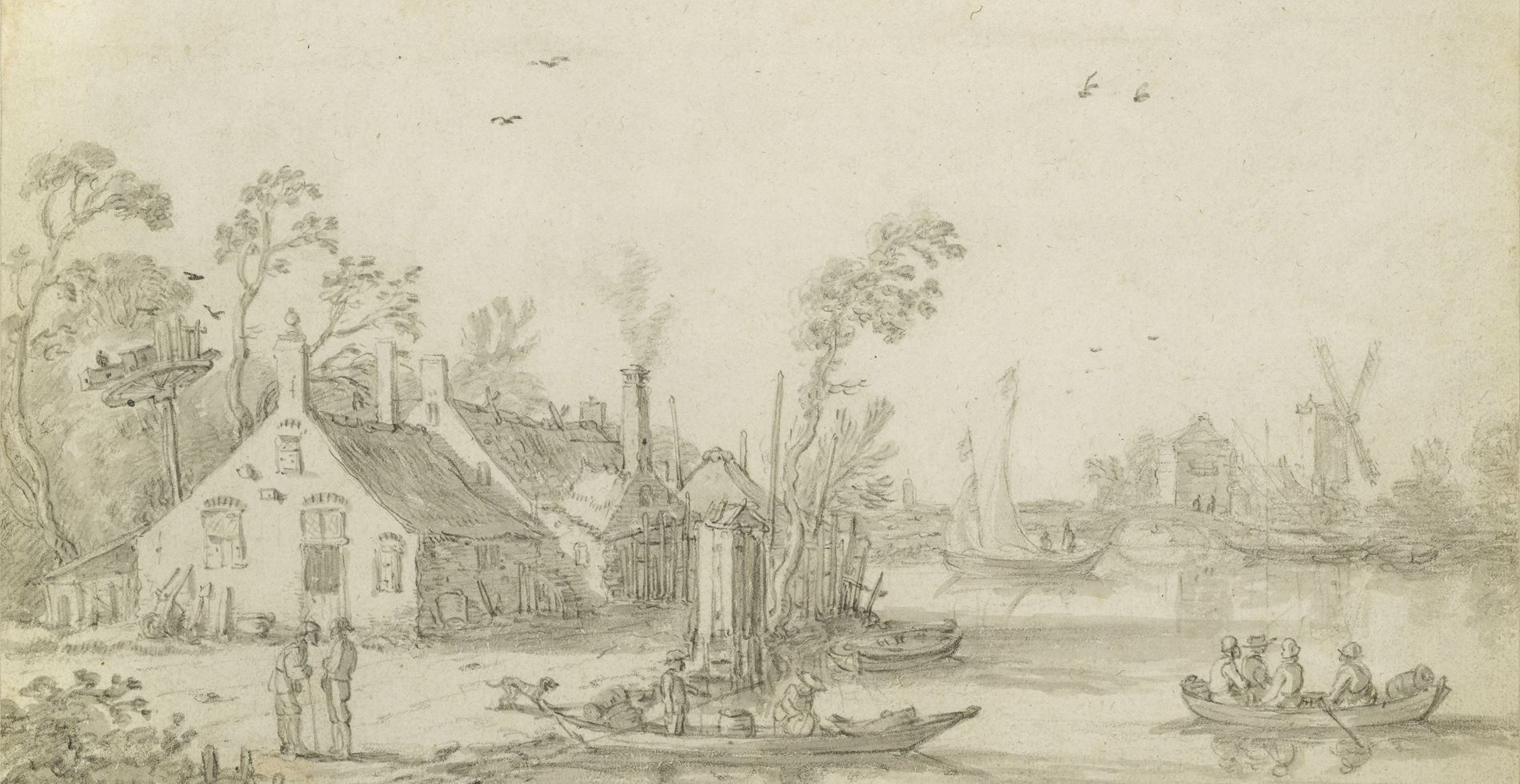
 contact
contact +44 20 7313 8040
+44 20 7313 8040


